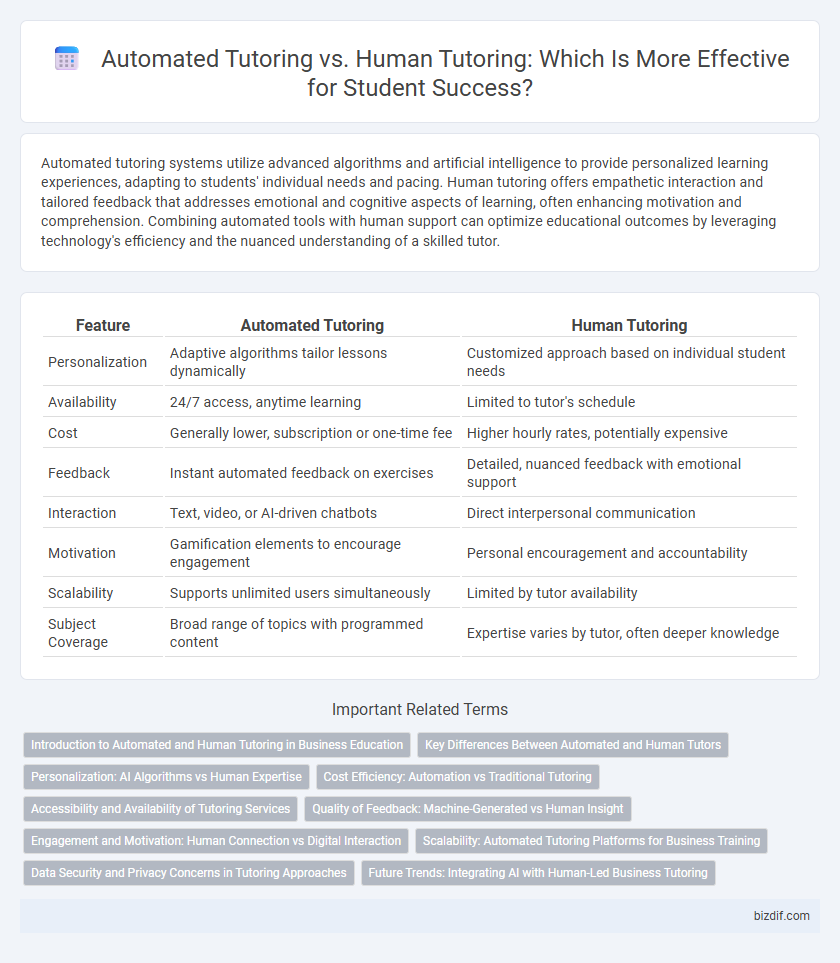Automated tutoring systems utilize advanced algorithms and artificial intelligence to provide personalized learning experiences, adapting to students' individual needs and pacing. Human tutoring offers empathetic interaction and tailored feedback that addresses emotional and cognitive aspects of learning, often enhancing motivation and comprehension. Combining automated tools with human support can optimize educational outcomes by leveraging technology's efficiency and the nuanced understanding of a skilled tutor.
Table of Comparison
| Feature | Automated Tutoring | Human Tutoring |
|---|---|---|
| Personalization | Adaptive algorithms tailor lessons dynamically | Customized approach based on individual student needs |
| Availability | 24/7 access, anytime learning | Limited to tutor's schedule |
| Cost | Generally lower, subscription or one-time fee | Higher hourly rates, potentially expensive |
| Feedback | Instant automated feedback on exercises | Detailed, nuanced feedback with emotional support |
| Interaction | Text, video, or AI-driven chatbots | Direct interpersonal communication |
| Motivation | Gamification elements to encourage engagement | Personal encouragement and accountability |
| Scalability | Supports unlimited users simultaneously | Limited by tutor availability |
| Subject Coverage | Broad range of topics with programmed content | Expertise varies by tutor, often deeper knowledge |
Introduction to Automated and Human Tutoring in Business Education
Automated tutoring systems in business education leverage artificial intelligence to provide personalized learning experiences, adaptive feedback, and scalable support for students seeking to master concepts like finance, marketing, and management. Human tutoring offers nuanced understanding, real-time interaction, and the ability to address complex, context-specific questions, enhancing critical thinking and problem-solving skills in business scenarios. Integrating automated and human tutoring methods can optimize learning outcomes by combining efficiency with personalized mentorship in business education.
Key Differences Between Automated and Human Tutors
Automated tutoring systems rely on AI algorithms to provide personalized learning paths and instant feedback, whereas human tutors offer adaptive emotional support and nuanced explanations tailored to individual student needs. While automated tutors excel in consistency and scalability, human tutors bring empathy, flexibility, and real-time problem-solving abilities that AI currently cannot replicate. The key difference lies in the balance between technological efficiency and the interpersonal connection crucial for effective learning outcomes.
Personalization: AI Algorithms vs Human Expertise
Automated tutoring leverages AI algorithms to analyze students' learning patterns and adapt content in real-time, providing highly personalized learning experiences based on data-driven insights. Human tutoring relies on expert educators who tailor instruction through emotional intelligence, intuition, and contextual understanding, offering nuanced feedback beyond algorithmic capabilities. While AI excels at scalable, consistent customization, human tutors bring empathy and adaptability essential for complex learning needs.
Cost Efficiency: Automation vs Traditional Tutoring
Automated tutoring significantly reduces costs by minimizing the need for human instructors and enabling scalable, on-demand learning experiences through AI-driven platforms. Traditional human tutoring involves higher expenses due to personalized attention, limited availability, and scheduling complexities. Cost efficiency in automated tutoring also stems from consistent content delivery and instant feedback, which can accelerate learning at a fraction of the cost.
Accessibility and Availability of Tutoring Services
Automated tutoring platforms provide round-the-clock access to educational resources, eliminating geographical and time constraints often faced in traditional human tutoring. These AI-driven systems can accommodate a large number of students simultaneously, ensuring immediate assistance and personalized feedback without scheduling conflicts. However, human tutoring offers nuanced understanding and adaptive interaction, which can be crucial for complex problem-solving and emotional support.
Quality of Feedback: Machine-Generated vs Human Insight
Automated tutoring systems offer instant feedback by leveraging artificial intelligence to analyze student responses and provide targeted hints, though they may lack the depth of understanding necessary to address nuanced misconceptions. Human tutors deliver personalized feedback grounded in emotional intelligence and contextual awareness, enabling adaptive explanations that cater to individual learning styles. The quality of feedback from human insight often surpasses machine-generated responses in fostering critical thinking and promoting long-term comprehension.
Engagement and Motivation: Human Connection vs Digital Interaction
Human tutoring fosters deeper engagement and motivation through personalized emotional support and real-time feedback, creating a strong learner-tutor connection. Automated tutoring systems utilize adaptive algorithms and gamification techniques to maintain motivation but often lack the nuanced understanding and empathy found in human interactions. Research shows students engaged in human tutoring sessions demonstrate higher persistence and intrinsic motivation compared to digital-only platforms.
Scalability: Automated Tutoring Platforms for Business Training
Automated tutoring platforms significantly enhance scalability in business training by delivering personalized learning experiences to large audiences simultaneously. Unlike human tutoring, these platforms use AI algorithms to adapt content dynamically, ensuring consistent quality and tracking employee progress efficiently. This scalability reduces costs while maintaining effective knowledge transfer across diverse organizational levels.
Data Security and Privacy Concerns in Tutoring Approaches
Automated tutoring systems often raise significant data security and privacy concerns due to the extensive collection and storage of sensitive student information on digital platforms. Human tutoring typically involves less data retention and offers greater control over personal information, reducing the risk of unauthorized access or breaches. Ensuring compliance with regulations such as FERPA and GDPR is critical for both approaches, but automated systems require robust encryption and secure data handling protocols to protect learner privacy effectively.
Future Trends: Integrating AI with Human-Led Business Tutoring
The future of tutoring integrates AI-powered analytics with human-led business coaching to deliver personalized learning experiences and real-time feedback. Advanced machine learning algorithms analyze student performance data to identify skill gaps, allowing human tutors to tailor sessions more effectively. Hybrid models combining automated tutoring systems with expert human guidance enhance engagement, adaptability, and outcomes in business education.
Automated Tutoring vs Human Tutoring Infographic

 bizdif.com
bizdif.com